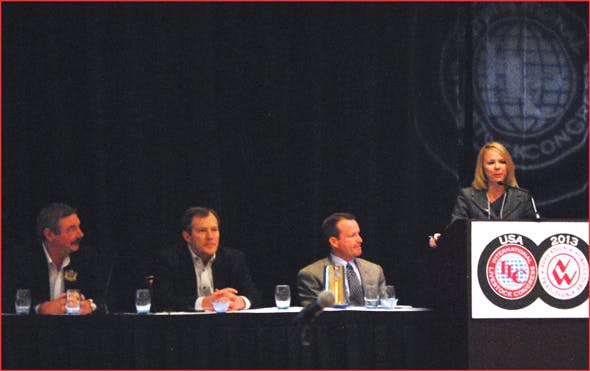Key Industry Topics Addressed at International Livestock Congress

Leann Saunders leads a traceability panel discussion with (seated, from left) Mark Gustafson of JBS USA, Rick Stott of AgriBeef and John Butler of Beef Marketing Group
Leann Saunders, USMEF vice-chair and president of Where Food Comes From, Inc. (formerly IMI Global, Inc.), moderated an informative panel discussion on livestock traceability. Panelists included Mark Gustafson, vice president of international sales for JBS USA and a member of the USMEF executive committee, John Butler, CEO of Beef Marketing Group, and Rick Stott, executive vice president of AgriBeef Co.
Saunders provided an overview of the new USDA animal disease traceability rule, but the panel’s main focus was on voluntary beef industry initiatives that employ traceability as a branding and marketing tool.
“As a company, we’re really trying to focus on those industry practices that consumers have lost sight of,” she said. “We’re reconnecting them with the family farms and ranches and great companies that are producing their food, and communicating all the wonderful things that our customers are doing with regard to animal identification and traceability in the supply chain.”
Gustafson addressed the importance of traceability to international customers, noting there are growing concerns about the U.S. industry falling behind its competitors.

Philip Seng discusses global economic issue affecting the meat industry with panelists (seated, from left) Guillaume Roué, Arturo Llavallol and Hsin Huang
“When we talk to customers, they are shocked that the United States doesn’t have the most robust animal identification and traceability system in the world, because they know that the U.S. industry is always on the cutting edge of technology,” he said. “They can’t believe that we can’t get a system in place – but the fact is, we don’t have one.”
USMEF President and CEO Philip Seng moderated a panel representing the executive council of the International Meat Secretariat (IMS), which included IMS General Secretary Hsin Huang, IMS President Arturo Llavallol, who is also director of Sociedad Rural Argentina, and Guillaume Roué, a pork producer from the French Interprofessional Pork Organization (INAPORC). This panel focused on a variety of key economic issues facing the meat and livestock industry worldwide.
“When we look at the IMS, it’s really an organization in which competitors have come together to try to improve the atmosphere in which we conduct business,” Seng said. “So the goals of the IMS are very noble, and it’s very beneficial for us to hear from the panel we have assembled today.”
Huang noted that the meat industry faces a formidable challenge of effectively conveying to consumers the quality of its products and the important role meat plays in a balanced diet.
“Today’s consumers are increasingly sophisticated but also, unfortunately, more and more influenced by a lot of the ‘noise’ that is out there on social media and other outlets that is not necessarily giving them a balanced picture,” Huang explained. “There is a perception out there that producing meat is harmful to the environment, has a terrible impact on our climate and a negative impact on our health. We know these things are not true, but how do we effectively communicate this to the consumer? We can either react to what is thrown at us, or choose to be more proactive.”

From left, USMEF Technical Services Manager Cheyenne Dixon, Jose Miguel Arias, Mauricio Lastra, Lucio Lastra and Dr. Nelson Huerta
Dr. Nelson Huerta, USMEF-Mexico technical services director, hosted a team of young livestock industry leaders at the ILC meeting as part of a three-year exchange program designed to foster positive relations between the U.S. and Mexico cattle industries. Mauricio Lastra and Lucio Lastra represented the Mexican Cattlemen’s Confederation (CNOG, a cow-calf producers association), while Jose Miguel Arias represented the Mexican Cattle Feeders Association (AMEG).Paul Clayton, USMEF senior vice president for export services, served as moderator for two ILC general sessions. In “Telling the Beef Story,” Dr. Gary Smith of Colorado State University provided a history of the advancements in beef industry production technologies. In “What Are Our Consumers Telling Us?”, John Lundeen of the National Cattlemen’s Beef Association gave an overview of the latest beef industry consumer research.
